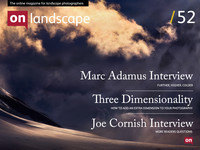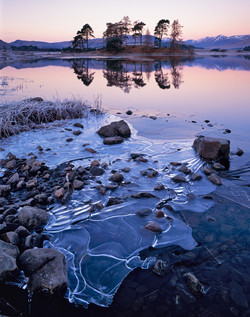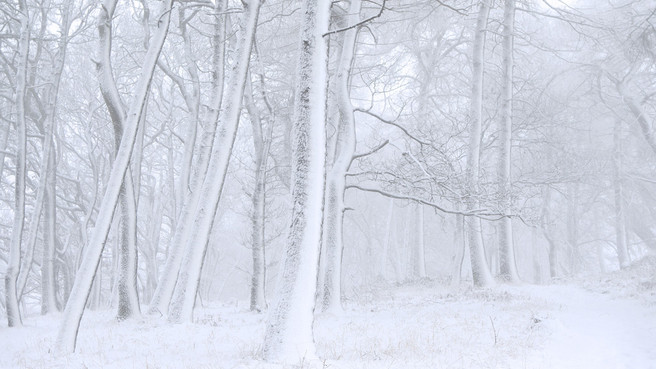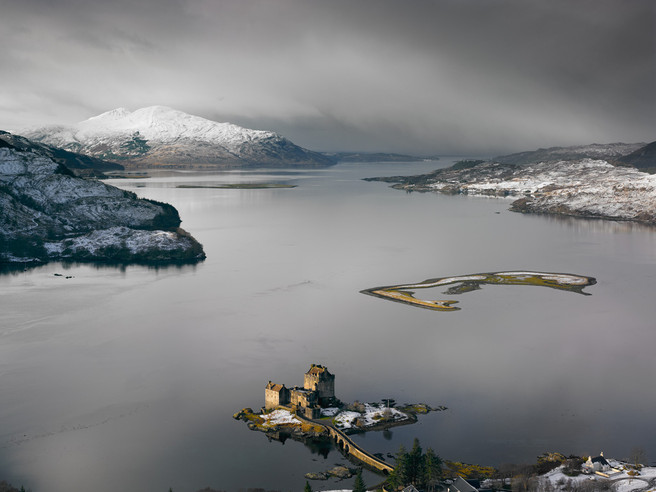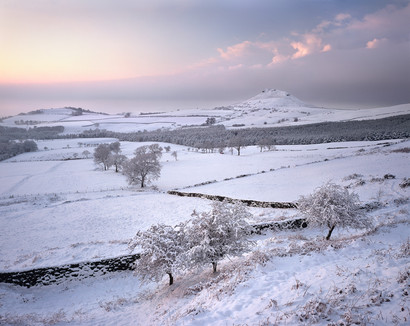Part Two

Tim Parkin
Amateur Photographer who plays with big cameras and film when in between digital photographs.

Joe Cornish
Professional landscape photographer.
Just before Christmas we asked our readers for a bunch of questions that we could put to Joe Cornish when he visited next and the response was fantastic. In the end we recorded two hours of audio but to keep installments to a useful length (a lot of people say they listen to them over breakfast or during a commute) we’ve split it into half hour sections.
So, a big thank you to Joe and everyone who submitted their questions and here’s the second section..
We've also included an incidental collection of snowy images to run alongside this item.
and a transcription...
Tim: Next question on Twitter from JM Images. ‘What long-term project trip has yielded the greatest disappointment? Sorry but hearing heroes fail cheers me up’ from John.
Joe: Thank you John. Right well, in a way it would be ridiculous for me to think I have been successful in anything. That may sound strange, but I always think that I could do better and everything feels a little bit like 'work in progress' in some ways.
When doing Scotland’s Coast and Scotland’s Mountains, which are both books I am proud of, the projects were fraught with the difficulties which accompanied working in Scotland itself, battling with the weather a lot of the time and the conditions. On both occasions there were ideas that I wanted to work on, images that I expected to make that I never made because of the conditions not ‘playing ball’.
With Scotland’s Mountains particularly, which is a step up in difficulty from Scotland’s Coast, I learned fairly early on that I was not going to be able to create these mythical images that I had in my mind and that I would have to simply deal with what was there. The learning journey for me was in not actually having these masterpiece images at the forefront of my mind, but simply to be, to quote a zen-ish phrase, ‘in the present moment’, to accept it and to simply ‘go with the flow’. So, in a way, that was a successful discovery but what I am trying to answer John’s point by saying is just because the outcome looks like it was all intended, it may not be really really.
In many ways, the project for me will always be ongoing and Scotland’s Mountains, as a book, is a snapshot in time for Joe Cornish and that’s the reality of it. I am proud of it as far as it goes in that sense. I think one of the difficulties with photographers and photography is that there tends to be this pursuit of the hero picture.
Tim: Yes
Joe: Alex Nail, if we go back to him, Alex has made a few of those images, I hope he won’t mind me saying that, terrific images and great credit to him for finding himself in those places and achieving what he has done in places that require great endeavour to have reached them.
I actually tend not to look for those images so much anymore, not that I wouldn’t be happy to receive them if they came to me, but rather to actually simply go with my camera in a kind of ‘what if?’ state of mind and to discover what I find; to try and fuse the elements of the day with the process of the walk and see what I discover. So in a way it’s as open ended approach as it possibly can be.
Tim: Is this something you discovered with time, that a lot of photographers find it difficult to work in some conditions? I know we were talking earlier about the intense blue sky with sun at midday, that when you learnt more about using those conditions, you become a happier photographer? Is it more productive?
Joe: I think that’s a good point. I think there are a number of ways of being happier, but I think before that comes, the consideration is, how many pictures do you want to take every day? Because one of our problems generally is that those that are shooting digitally, shoot too many pictures and one of the lessons that I learned shooting large format is that you don’t need to shoot many pictures; because you are trying to make a picture, not necessarily that is a masterpiece, but that distils an idea, and that process isn’t necessarily made by shooting thousands of pictures and then selecting the best from thousands.
It’s about being very, very, very focused and aware; aware of where you are, of the moment, aware of the limitations of the process, aware of your personal journey, aware of the emotional state that you are in and developing that awareness. It is, in that sense, a form of meditation. I don’t think that is a pretentious thing to say, it’s a factual thing to say.
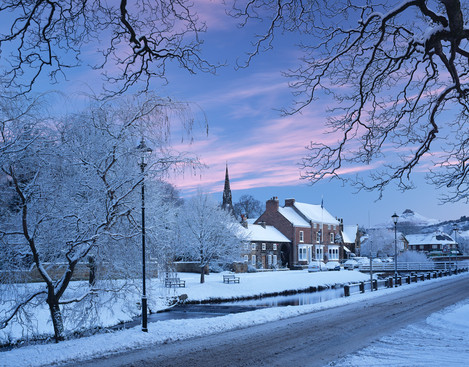 Coming into focus is actually what, in many ways, being a photographer is about and when you start to learn that habit, you can escape from the yoke of shooting thousands of photographs because, I can tell you, it is not an editing process. Editing is important but you do the editing before, it is important after you have taken the pictures too, but what I am saying is that it is not about selecting one picture that has worked out of thousands and I think most people, who are on landscape, will know that it is about learning to be selective and the more you can do in camera the better.
Coming into focus is actually what, in many ways, being a photographer is about and when you start to learn that habit, you can escape from the yoke of shooting thousands of photographs because, I can tell you, it is not an editing process. Editing is important but you do the editing before, it is important after you have taken the pictures too, but what I am saying is that it is not about selecting one picture that has worked out of thousands and I think most people, who are on landscape, will know that it is about learning to be selective and the more you can do in camera the better.
So that’s the first point, and then of course, with time you become more and more aware of the fact that conditions will dictate how successful you can be; because the language of light, the language of colour (which is part of the language of light), as well as your own agenda, will teach you that if you go out in the middle of the day in an exposed environment with a high sun and a blue sky, you are going to feel like you are pushing a very, very heavy stone up a very steep hill. It is really, really difficult to make pictures have atmosphere, meaning and a useful descriptive value in those environments, because of the way light works.
Tim: The next question is from Tom Wilkinson from Twitter. ‘I would like to know where Joe sees himself being in ten years’ time, in terms of his work.’
Joe:
I am much more interested in trying to live each day well, I think and I don’t even manage to do that all the time, especially a few lessons I have learnt this year have made me think ‘yes actually that is, above all, the main thing; to live each day well whether you are photographing or not.’
Tim: The journey…
Joe: Yes and I think, and we can get into this in detail later, if you think of yourself as an artist instead of a photographer, which without wishing to sound pretentious, I do think, from that point of view, I try to make art, whether you think it is or not is another matter, but that’s my goal.
Believe it or not, I try to make a living out of it, but I don’t put my photography as the principle way of making a living, I make my photographs mainly for me and I see it as an artistic process. The idea of having a ten year plan or ‘where am I going to be in ten years’ time?’ would kind of seem to imply that I might actually have a plan. So, the quick answer is no.
I don’t know, I really, really don’t know. I would like to continue to remain fit, healthy and active, which is where I am at the moment in my mid 50’s very fortunate to be in good health and I’m conscious of that. I feel, in a way, it is my responsibility to remain healthy for as long as I can to continue to challenge myself photographically, creatively and to continue to do what I can to help other people in that process as well, because for selfish reasons I get a lot out of that and enjoy it. I feel part of a community both at home with my family and in my immediate village that I live, also in the wider community of photographers, I do think there is such a thing.
I know that it’s not very fashionable sometimes to talk about that, but working as we do on landscape we realise that there are a lot of us who have a lot in common and shared goals to endeavour. There is a lot of support, encouragement and I think it is important to be part of that, so I would like to continue that.
Tim: Thank you. Axeman3UK, not sure who it is but this is from Twitter, ‘I would like to know, if Joe could only make one more image, what would it be and what would be his vision?’ It’s a tough one.
Joe: It is tough. I have always been interested in landscapes that are cold. I feel I have a lot of unfinished business with ice and, as it happens, I’m going to go to Antarctica in a few weeks’ time, so looking forward to doing a few things maybe I have never done before.
I love sculpture by the way and ice and sculpture seem to be part of the same aesthetic and the power of form. Michaelangelo is my favourite artist.
I find great inspiration from the forms of nature and ice is an ever changing extraction, so there is a lot in it for me to work with and play with. The fact that it is semi translucent and all of those things makes it just the most magical substance, I think, on the planet in many ways.
So lots there, so perhaps that would be it, but ... if you took this question as a kind of elegiac one, if you could make one image that would somehow fulfil or distil your life in photography or in terms of what you believe as a human being then it would probably be; I would be very predictable and say, I would like to make an image that combined the minutiae of the living world with the imaginative realm of the mountains, because I have lived such a lot of my imaginative life not just actually in the mountains but when I have been at home, thinking about mountains and about the prospect of mountains. So they are those ‘lift up thine eyes to the hills’, and I’m not a religious person by the way, in that sense. To me they are the inspiration, the gesture of the mountain, and I know it’s a cultural thing that I have received over the years, but the notion that this magical realm of snow and incredible views and light and danger...
Tim: A sense of the sublime...
Joe: All of those things. I have recently had a chance to scrutinise a lot of images by my friend Alan Hinkes, as you have. Alan is the first British person to climb all of the world’s eight thousand metre peak, and he is a very good photographer as well, and some of the pictures are literally sublime, it was a real reminder to me of why I love mountains. Seeing the things that happen at high altitude or even just in Scotland high up, for instance being on Ben More Coigah and seeing the Brocken Spectre and looking down on a sea of mist and seeing beautiful mountains emerging from that sea of mist.
So the realm of the mountains represents the kind of lofty aspirations of the human spirit and the physical tactility of the living planet, the plants, the flowers and the animals that make up our daily life are equally important to me. So could you make an image that synthesised those elements in one? Yes, I think one can and in a way that would probably be what I would look to do. So, I would shoot from the low lands to the mountains. But where?
Tim: Can you give us a few choices?
Joe: Yes, there are a few choices and I don’t want to be ‘pinned down’ at this point.
Tim: And the next question from Mark Shepherd, bit of an abstract question or statement 'process and creativity?’
Joe: Well the words process and creativity are fundamental to what we do in photography. But you know what, I think they are fundamental in the arts and I think it is a fascinating topic. I actually don’t worry about it nearly as much as I used to. ‘Is photography an art’? Discuss...
Process is inherently tied up, I think, with photography a lot. It is considered in the realm of art as a very technical form. Artists are very conscious of the fact that photographers are very obsessed about gear and I think they tend to kind of despise that in a way. It is slightly sad for us that, in many ways, we are all a little bit guilty for it.
Part of the reason for the obsession with process is because for me, and I think for many photographers who photograph landscapes, the power of the subject matter is absolutely at the heart of what we do and the power of the subject matter is the illusion of reality in the photograph - the presence of the landscape, whether it’s a close up or a wide view, a lot of the presence is to do with the optical trick that is photography; the way that the lens renders the reality of what we see in terms of light and form, texture and colour in the photograph, in the two dimensional representation whether it is on a screen or on a print or in a book or whatever it may be and we all know that the quality of the lens, film and sensor system is an indivisible art of that.
Ok, so that means if we are going to recreate the experience of being out on the mountain, on the beach or by the lakeside, wherever it may be, with great physical presence and authority we need a good camera and a good lens and a good workflow so all the technical side of it matters to us. Hence the kind of predilection for very high quality lenses blah, blah, blah. So process is important.
Oddly enough, the other thing about photography is that it isn’t like human vision so we aren’t actually literally recreating what we see, we are going through an interpretive process and that is where are personal decision-making reflects our creativity and that is very, very important and you can see it as completely separate to process, a lot of people would like to make that distinction. I know a lot of artists would.
Tim: ..and colour is all about science and craft...
Joe: Very much so and the types of colours and the things that they were trying to do with the limitations of the colours. When we look at Leonardo Da Vinci’s oil paintings, we tend to think that they are all very deliberate, well a) they have changed over time but b) they were limited by the colours that were available to him at the time and he developed his colour style from that process. The layering process of varnishes that typically painters like he used is something technically based and his vision and imaginative realm is the reflection of that technique and anybody who thinks differently is deluding themselves.
So photography, photographic creativity, is also inherently a reflection of process both the sights of photography itself and the limits on the materials, the methods and the equipment that is available to you at the time. I think that is a very important lesson to learn and is a great springboard because you can use the limitations and the oddities that our the photographic process; the whole out of focus, in focus, the weird and wacky colours that arise, the fact that you can manipulate, if you wish, the process in so many ways or you can use the manipulative power to try and recreate what you saw, whichever way you choose to go, it is all part of process and creativity, process and creativity to me are intrinsically linked and importantly so.
Tim: Next question from Guy Aubertin, and I think we will mention this and come back to it, but he says ‘more information and images on Joe’s trip to India. Pretty please’. I know you have done a talk on this already at the gallery, is there a possibility of another talk at the gallery that we can come along and record it?
Joe: I hope so, yes. I will keep my fingers crossed on that one. We are discussing it.
Tim: And, if not we will try and get a session on that... Magnus Lindbom says ‘It would be interesting to know how Joe thinks his images have changed over time from the beginning to today.’ a short version perhaps
Joe: In a short version, how long have I got? Yes, I think my images have changed but I also think there is a cyclical process in it. I look back at my work as a student and see the proto style of my work then and I can see a direct link.
When I first went out with a camera, before even my degree show which are the pictures I tend to look at now, the first photographs I took were of trees in the woodland, on the campus at Reading University where I was a student, and I had barely used a camera before that and they were looking up, they were looking at the shapes of the trees that had fallen over and the radial patterns of the roots that were lying on the ground and my ideas were springing from my interest in natures and the shapes of nature.
When I was doing my degree show, I was twenty, twenty one I suppose, my pictures were of light shining off shapes on the sand at beaches or off rocks, what I do now is ... I still do exactly the same thing, the same subject matter and, in some ways, in the same ways but with perhaps a greater understanding, I would hope, of the certainly of the ascetic possibilities of the medium and with an eye to trying to emphasise that.
However, there is a kind of metaphoric or an anthropic connection because my agenda has become broader and perhaps a little less personal, in the sense that when you are a student you are not sure what you are doing and you are trying to find something that will justify your existence as a student. Whereas now, I am more confident in my goal to connect personally to the subject and try to share that feeling of connection through the way that I design my compositions and use light and that’s quite deliberate thing. But in some ways it has changed and yet it hasn’t changed.
Tim: Next question from John Dunn, ‘I would like to understand a little more about the business side of landscape photography. How does Joe approach commissions, tender day rates versus fixed day licensing exclusivity etc. etc. Any insights into this topic, which I have never seen discussed, for our genre of photography before, anywhere, would be eliminating.’
Joe: You know, you always want to be a pioneer or you would like to be in a creative realm and it would be quite ironic if I was the first person to talk about the business of being a Landscape Photographer for public consumption.
You know, there are a number of photographers in the UK who do commissions, not a huge number but there are a number, I know quite a few and not all of them are full-time professionals many are successful semi-pro’s or retired people who have been successful enough to get asked to do commission work. So it is a very big and wide cross section of the, you could say, ‘old school of hard knocks’ and that would be myself, Colin Prior and David Noton for example. My guess is that we are all, somewhat, different in the way that we do things.
My approach to commissions is, to answer the question as directly as possible, I don’t get many I only have a few people who I work for, first of all find out very clearly what somebody wants because it is very, very easy in photography to disappoint clients and that’s the truth and the difficulty.
I quite often get asked by private clients ‘can you photograph such and such a place, because I have fond memories or recollections of it from when I was a child’ and this person now has enough money to buy a personal commissioned piece of work. This is a lovely, lovely idea and my instinct is always to say ‘yes, I’d love to do that for you’ and then try to think how much and long is it going to take me, you have to value your time in that way. I have found from the experience of doing those photographs that they really, really rarely work. It is really difficult because however great your work is this person will have an idea or an imaginative memory...
Tim: And you are trying to photograph their vision.
Joe: And, you can’t do it. Even if, your client is very magnanimous, you do your level best and you confirm you will charge X amount for your time, whatever that may be for a day’s work, and you go out, do that picture and spend quite a bit of time of post-production and so on and so forth, the chances are you will disappoint them. If they are magnanimous or they are very open minded it can work but I tend to shy away from them now.
So, the sort of commissions I generally do, if we get back to the question, are for say the British Tourist Authority, also called Visit Britain, and the National Trust, they are my two biggest clients. Fortunately, I have lots and lots of mileage with them already so...
Tim: You know roughly what they want?
Joe: I do. I know what they are about and they know what I am about and so we are able to work, usually, without having to brief me too thoroughly and they know I know what they want.
Sometimes, especially with the trust over the years, we have had to have discussions about how their needs are changing with time and that’s fine, that’s what you would expect and sometimes for me to be more creative I have to be more open minded or I have to tackle something that I do not necessarily want to do to make sure they get value for money.
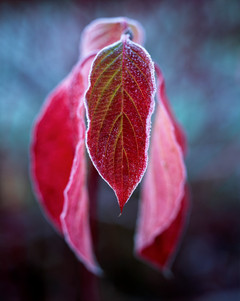
So the next point to say is that for me, as a working man, it is very important to me that I feel my clients gets value for money. That is my primary goal almost and I try to do that by firstly give them what they want, secondly, give them more than what they want. If you can do the primary objective and then to also give them more than what they want, then that’s great, because clearly that’s good PR for you.
How do you do that? Well, you might think you go out with a pre-determined vision of what they want and then you do it for them. But the weird thing is, I still make those pictures for me, so when I am using my camera and my tripod out on the hill, or wherever it may be, while I may have in the back of my mind ‘this must be palatable and understandable’ as in it’s not too obscure, I am still photographing to satisfy my own sense of trying to make a great picture or a good picture or one that is at least has interesting qualities that has a narrative and has a point to it.
Tim: And, that is presumably because they are not hiring you because they cannot use a camera themselves; they are hiring you because they want your view.
Joe: Yes to coin a phrase ‘they want your vision’ and every photographer I believe, in that position, if they have been commissioned, should try to stick to that principle because trying to second guess what somebody else wants rather than in the model I mentioned earlier is almost bound to be doomed to fail. So you have got to be yourself.
Tim: Beware the client who says it’s just an open brief...
Joe: Well, in some ways, especially if you don’t know them. So try and be absolutely clear about that with them. I mean a commission is an honour, really to be commissioned to photograph for somebody, especially if it’s an artistic commission opposed to shooting a wedding or a portrait some portraits can be seen in that way and they may wish to have your style by the way, but we are talking about landscape photography here, it is ordinarily I would say, it is because of the artistic component that they are looking for your artistry and you have to remember that. I hope that answers the question.
Tim: I think so. Well, there is a question about rates and licensing.
Joe: Briefly, oh and there is tender. So day rates, you have got to decide what you are happy to work for, unfortunately these days it’s not very much because if you think you are worth thousands and thousands of pounds a day, that’s great but will your client think you are?
Well, I’m sorry, but most clients these days know that they are in a buyers’ market and they probably think that they can get somebody who is still pretty damn good for a few hundred quid a day. That’s the reality and they are probably right. So, you have to be mindful of that.
Day rates versus fixed rates, I think you have to be careful of fixed rates but if your client has a budget in mind, you then have to decide ‘is that doable in a way that is agreeable to me and I’m not going to end up resenting doing it’ … so that’s clear.
Licensing and exclusivity, personally I would say that any photographer of my generation would wish and expect to keep the copyright but saying that I think you have to be flexible and if you believe that ultimately the client is really, really keen to have the copyright and the money is reasonably good in other expects then, well, you have to balance that against what your needs are in your daily life and there are times when you have to say OK fine.
Tim: But, where at all possible, make it in some way rights managed; licensed in some way.
Joe: Yes, I personally would say always keep the copyright and give them a licence to use that is generous but that is limited.
Tim: Non-perpetuum.
Joe: Never in sur perpetuity, you should always aim to keep the rights to your photography, that is part of the underlying philosophy that lead to the drawing up of the copyright of 1989 as it is and that philosophy is based on what you would call natural justice. Which it is to say that the creator is the originator and the owner of the work.

